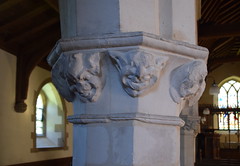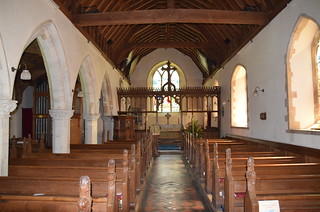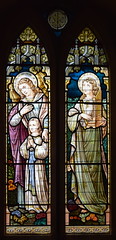| |
|
All
Saints, Salhouse I'd been
here before, many years ago on a day in the deepest
winter, the temperature hovering around zero, the wintry
air clouding our breath. It was trying to snow, the sheep
across the Salhouse road huddling miserably in the
flurries. I found the church locked on that occasion, the
police insisting that it be kept so according to the
cheery churchwarden that I rang. It was the only locked
church for miles, and I couldn't understand why, but he
came and opened up for us anyway.
Coming back in the pleasant summer of 2019, I found the
church open, with a sign saying it is now kept so every
day. This is a busy area for tourists, being just south
of Wroxham and on the edge of the Broads, but the church
is set remotely away from its village in a narrow sleeve
of a churchyard that opens out beyond to the east.
The squat tower was clearly intended to be taller, and so
it was either taken down or is unfinished. Will evidence
shows that the latter is the case, and it was the
Reformation, with its removal of the need for bequests,
that interrupted the funding for the work. However, there
is another puzzle. If you look from the east you can see
that the tower is offset, and a large tower arch peeps
above the roofline of the nave. Clearly, the intention
was to rebuild the nave after the tower.
This is a curious way of going about things, and is
presumably a sign that the rebuilding of the tower was
considered the higher priority. The north aisle of the
church is very early, the arcade dating from the 13th
century. We may assume that it would have been swept
aside by the rebuilding work. At the extreme west of the
aisle, hidden in the vestry, is a very curious massive
archway, which may well have opened into the tower of the
original building, perhaps a Saxon church on the site of
the north aisle. If they had finished the early 16th
century tower then it would certainly have been an
opulent one. As it is, it tops out directly above the
belfry, and the low brick parapet is a later addition.
There are magnificent sound holes with animals as the
headstops to the arches.
Even on a sunny day this is a fairly gloomy interior
thanks to the extensive range of coloured glass, and the
low aisle with its wide arcade creates a sense of a wide,
low space. The Victorian restoration was heavy but not
overwhelming, and in any case the 19th Century glass is
some of the most interesting of its kind in this part of
Norfolk. It is a complete scheme installed over the last
quarter of the 19th Century by Alex Booker of Bruges,
Belgium. This is an unusual workshop to find, but
Salhouse has other singularities. Carved capitals to the
arcade are unusual in East Anglia, but there are several
here, and the most westerly one has a ring of carved
heads, mostly vandalised, including a devilish fellow
looking west.
 
The pulpit has an unusual hourglass
holder, which for many years was converted into a lamp,
but now contains a (modern) glass again. The font is a
little odd, because the shaft is carved and decorated,
but the octagonal bowl is plain. Perhaps they were not
always together. Back in 2005, the churchwarden confirmed
Mortlock's story that the font came from Woodbastwick at
the time of the rebuilding there, "but don't tell
them, they might want it back!" In 2019 I was
pleased to see that no enmity had arisen between the two
neighbouring parishes, and the font was still in place.
I have a vivid memory of my visit
in the winter of 2005. The churchwarden was very patient
and generous with his time. He suggested I go up the
tower and take a look at the bells - "but don't go
out on the roof, I don't think we are insured for
that!" I have a fear of heights, but a fascination
with church towers. It is a battle of wills in which both
wills are mine. I suppose that many of us are fascinated
by our fears. I took him up on his offer, and climbed the
ancient stairwell, passing occasional slits opening out
into the grey light.
Eventually, I came to the neatly-kept bell stage. It
seemed curious to see the sound holes from the inside.
The frame contains two bells, the pre-Reformation
inscription on the nearest pleasingly clear, the date
1441. The other dates from the 17th century. I carried on
up the stairway, but after another thirty steps or so it
came to a stop, the steps topped out in stone. Here was
where the money ran out. A small window gave out onto the
roof of the tower.
The low parapet was terrifying, the air freezing, the
wheeling sleet enhancing the sense of vertigo. I
nervously took a photograph northwards from the top, and
then hurried back down again, grinning like a mad thing.
A small victory over myself.
Simon Knott, November 2019
Follow these journeys as they happen at Last Of England
Twitter.
   < <
   
   

|
|
|
